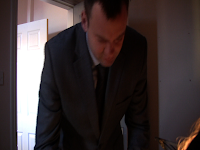
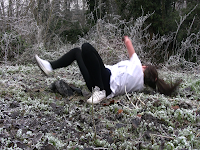
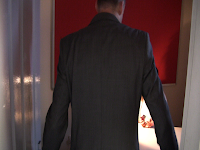
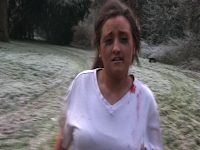
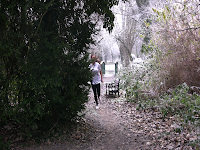
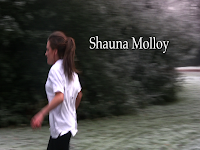
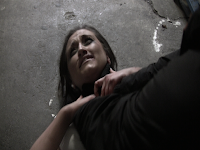
Title
- The first 3 screen shots show the credits and titles. Big bold writing with a sinister looking font for Red Handed.
- Simple titles for the producers and cast fits in with the norm for psychological thrillers we used a float of effect to add a bit more scary feeling. We decided moew muted credits will help the audience take the film more seriously than over the top animation.
- Red colour was used for Red Handed to link in with the film theme with is quite sinister and related to violence.
Characters
- Psychological thrillers tend to cast a young female as the main role and have a stronger man playing the villain we felt we should conform to this generality so choose our characters to fit.
- We also wanted a contrasting male character one being good so we picked an actor who looks like he could be a real detective in real life: quite fit, speaks well showing he is clever.
Mise-en-scène
- We choose a very isolated area to make it seem more threatening.
- Running through a forest is scarier than running though a housing estate. This is because the forest has sense of hidden dangers - hence the popularity of this scene in our genre.
- Typical psychological thrillers have scenes where bad things happen deep in the woods so we were also trying to recreate that.
- Filmed the outside of a real police station to create verisimilitude.
- Very cramped interrogation room use of a lamp to create a typical interrogation situation - this adds a different threat to the main character and contrasts the open outdoor space. Again, movement from outside in is familiar in our genre.
- Abuse scene was filmed in a basement to help set the scene making it seem more run down and sinister - a conventional use of setting.
- Props such as the knife and the fake blood to add extra emphasis to the scene making it seem more real and scary. Police badge helps create his persona.
- Shauna’s costume helps emphasis the fact she has been abused ripped and stains plus make up done to make it look like she’s been cut and been crying adds to the realness and seriousness of her situation.
Camera work
- Beginning starts with a close up to help the audience identify with our main character and so they can figure out that she is the main character.
- Used a 360 shot to show the harm to Shauna’s face and the extended face time helps the audience to sympathise with her as a character. This is a rare camera movement to be used in thrillers but is conventionally used to show disturbance and disorientation.
- We used lots of different camera angles for the abuse scene in hopes to distort the images and hopefully distort the audience’s idea of what’s happening. Extreme close ups are used to keep the identity of the attacker concealed.
- Standard shot-reverse-shot used in interrogation scene commonly used in psychological thrillers so we can see both characters expressions while they talk.
- Tracking shot while she is running this is all shaky and is a similarity to what she would be seeing while running and helps to engage the audience more.
Editing
- We used a lot of short cuts and cross cutting to create a fast paced and dynamic feel to the beginning of the clip very commonly used in psychological thrillers for the action parts.
- Cross cutting between 360 shot and abuse scenes create a contrast between calm and chaos which keeps the audience on their toes.
- We used ellipsis from the police station to help save time and get straight into the interrogation scene.
- Continuity editing is used at police station to show normality returning.
Sound
- We have a soundtrack of non-diegetic music playing underneath half of the clip to help create sad emotions while she is getting abused then during the running scene a heavier thumping track is used to create a tenser atmosphere. Music like this is very common in psychological thrillers and helps set scenes and intensify emotions.
- Dialogue from the detective helps us see that he is trying to help the girl and is kind towards her.
- During the interrogation scene we put screams quietly while the camera was focused on shuna this creates the effect that she is thinking about what happened to her and how awful it was.
- We have not really broken or twisted any conventions in our piece but in the main have stuck firmly to genre conventions in terms of mise-en-scene, plot, sound and character.
- We have also kept to formal conventions (opening sequence) with our editing and use of titles and credits.
- This could be criticised in some ways as not being original or inventive.
- However, I would defend our choices in terms of genre with Dyer's theory that audiences feel 'safe' with genre texts and want to know what they are getting.
- By using familiar genre conventions we have made sure our audience feels right away that they are in for a good thriller with twists and turns and an eerie atmosphere.
- This also makes good commercial sense - as discussed when we thought about our distributor, these are popular films that do well in the box office but not as well as action thriller films. We are not in an economic climate where small institutions can take big risks with quirky, unusual films as it might not pay off.
- It therefore makes sense financially for us to stick with what we know works - which we have done.





No comments:
Post a Comment